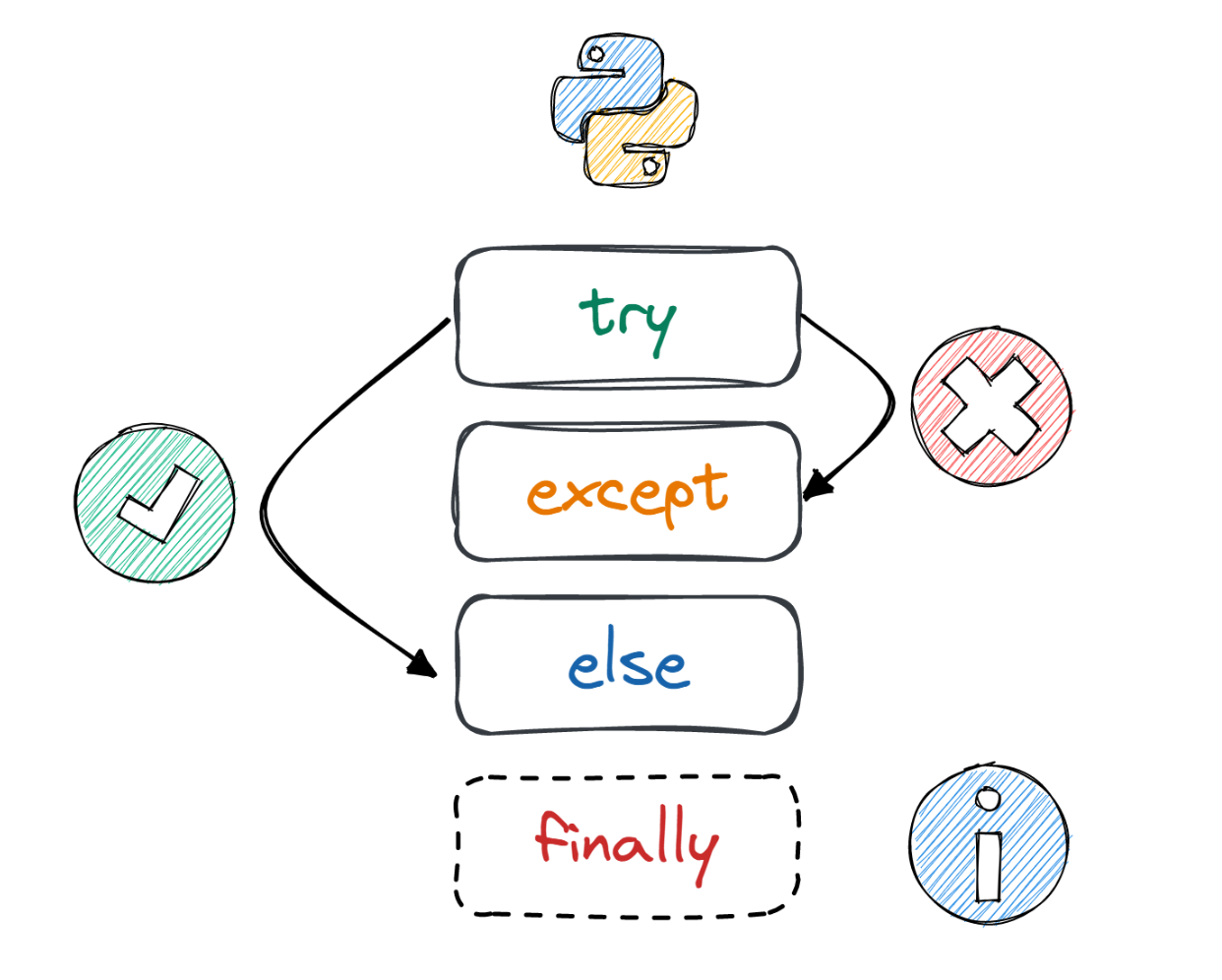
Error Handling and Debugging in Python: A Comprehensive Guide
Part 8 : Python for Scripting
Welcome to Part 8 of our Python for Scripting series! In this segment, we'll explore the critical aspects of error handling, exception handling, and debugging techniques in Python, particularly valuable for DevOps and cybersecurity-related automation tasks.
Exception Handling in Python

Python provides robust mechanisms for handling exceptions that occur during program execution. Key constructs include try, except, else, and finally.
Basics of Exception Handling
try:
result = 10 / 0
except ZeroDivisionError as e:
print("Error occurred:", e)
else:
print("No errors detected.")
finally:
print("Exception handling complete.")
Explanation:
The
tryblock attempts the code that might raise an exception.The
except ZeroDivisionError as e:block catches and handles the specificZeroDivisionErrorexception, printing the error message.The
elseblock executes if no exceptions occur within thetryblock.The
finallyblock always executes regardless of whether an exception occurred or not.
Expected Output:
Error occurred: division by zero
Exception handling complete.
Handling Real-world Scenarios
def open_file(filename):
try:
with open(filename, 'r') as file:
contents = file.read()
print("File contents:", contents)
except FileNotFoundError as e:
print("File not found:", e)
open_file("example.txt")
Explanation:
The
open_file()function attempts to open a file for reading.If the file does not exist, it raises a
FileNotFoundError, which is caught and handled by theexceptblock.In the
exceptblock, an appropriate error message is printed.
Expected Output:
File not found: [Errno 2] No such file or directory: 'example.txt'
Debugging Tools and Techniques

Effective debugging is crucial for identifying and fixing issues in code. Python offers various debugging tools and techniques, including print statements and dedicated debugging libraries like pdb.
Utilizing Print Statements for Debugging
Print statements are a simple yet effective method for debugging. They help display intermediate values and messages during code execution.
def calculate_division(a, b):
print(f"Dividing {a} by {b}")
try:
result = a / b
print("Division result:", result)
except ZeroDivisionError as e:
print("Error:", e)
calculate_division(10, 2)
calculate_division(8, 0)
Explanation:
The
calculate_division()function attempts division and usesprint()statements strategically to display values and messages.It prints the numbers being divided and the result.
If a division by zero occurs, the
ZeroDivisionErroris caught and handled, displaying an appropriate error message.
Expected Output:
Dividing 10 by 2
Division result: 5.0
Dividing 8 by 0
Error: division by zero
Debugging Complex Code with pdb
Python's built-in pdb library offers a powerful debugging environment allowing step-by-step code execution and variable inspection.
import pdb
def complex_function(a, b):
result = a * b
pdb.set_trace() # Start debugging session
result += a + b
return result
complex_function(5, 10)
Explanation:
pdb.set_trace()sets a breakpoint in the code, initiating a debugging session.When the code reaches this point, it halts execution, and you can interactively inspect variables, step through code execution, and identify issues.
Commands like
step,next,continue, andprintcan be used to navigate through the code.
Expected Output (Debugging Session):
> ...path to file...
(Pdb) continue
Additional Debugging Techniques
Logging for Debugging
Using the logging module helps trace the flow of your program by logging messages at different severity levels.
import logging
logging.basicConfig(level=logging.DEBUG)
def some_function():
logging.debug('This is a debug message')
# Rest of the function code
Using IDE Debuggers
Integrated Development Environments (IDEs) like PyCharm, Visual Studio Code, etc., offer built-in debuggers allowing breakpoints, step-by-step execution, and variable inspection within the IDE environment.
Assertion for Debugging
assert statements are helpful to test conditions that should hold true during code execution. If the condition fails, it raises an AssertionError, highlighting potential issues.
def validate_input(value):
assert value > 0, "Value must be positive"
# Rest of the function code
These debugging techniques expand your toolkit for troubleshooting and resolving issues in Python code, essential for DevOps and cybersecurity-related automation tasks.
Practical Exercises

Exercise 1: Handling File Not Found Error
Create a function that attempts to open a file and handles the FileNotFoundError exception.
Expected Output: (Dependent on file existence)
Exercise 2: Debugging Loop Logic
Identify and fix a logical error in a loop that iterates through a list of numbers and performs a calculation.
Expected Output: (Corrected results of the calculation)
Exercise 3: Utilizing pdb for Debugging
Experiment with Python's built-in pdb library to debug a complex function or program.
Expected Output: (Interactive debugging session information)
Exercise 4: Handling Input Validation
Write a script that validates user input and handles possible exceptions related to incorrect input formats.
Expected Output: (Appropriate messages for valid/invalid inputs)
Exercise 5: Custom Exception Creation
Define a custom exception class and use it to handle a specific scenario in your code.
Expected Output: (Handled custom exception messages)
Mastering error handling and debugging in Python is pivotal for DevOps and cybersecurity-related automation tasks. Practice these exercises to enhance your troubleshooting skills and streamline your automation workflows! Stay tuned for more Python scripting adventures.
Solutions to Regex Practical Exercises
Exercise 1: Phone Number Validator
import re
def validate_phone_number(phone_number):
pattern = r"\(?\d{3}\)?[-.]?\s?\d{3}[-.]?\s?\d{4}"
if re.match(pattern, phone_number):
return True
return False
# Testing the function
phone_numbers = [
"(123) 456-7890",
"123-456-7890",
"123.456.7890",
"123 456 7890",
"1234567890"
]
for number in phone_numbers:
if validate_phone_number(number):
print(f"{number}: Valid phone number")
else:
print(f"{number}: Invalid phone number")
Explanation:
The function
validate_phone_number()uses regex to check various phone number formats.The regex pattern
\(?...matches optional parentheses, followed by digits and optional separators.
Expected Output:
(123) 456-7890: Valid phone number
123-456-7890: Valid phone number
123.456.7890: Valid phone number
123 456 7890: Valid phone number
1234567890: Invalid phone number
Exercise 2: Password Strength Checker
import re
def check_password_strength(password):
pattern = r"^(?=.*[A-Z])(?=.*[a-z])(?=.*\d)(?=.*[@$!%*?&])[A-Za-z\d@$!%*?&]{8,}$"
if re.match(pattern, password):
return True
return False
# Testing the function
passwords = [
"P@ssw0rd",
"Weakpass",
"StrongP@ss123!",
"AnotherStrong#123"
]
for pwd in passwords:
if check_password_strength(pwd):
print(f"{pwd}: Strong password")
else:
print(f"{pwd}: Weak password")
Explanation:
The function
check_password_strength()utilizes regex to validate password strength.The regex pattern enforces criteria: minimum length (8 characters), uppercase, lowercase, digit, and special character.
Expected Output:
P@ssw0rd: Strong password
Weakpass: Weak password
StrongP@ss123!: Strong password
AnotherStrong#123: Strong password
Exercise 3: URL Extractor
import re
def extract_urls(text):
pattern = r"(https?://\S+)"
urls = re.findall(pattern, text)
return urls
# Testing the function
block_of_text = "Visit my site at https://example.com or see more at http://blog.example.com"
extracted_urls = extract_urls(block_of_text)
print("Extracted URLs:", extracted_urls)
Explanation:
The
extract_urls()function uses regex to find URLs in a block of text.The regex pattern matches HTTP or HTTPS URLs.
Expected Output:
Extracted URLs: ['https://example.com', 'http://blog.example.com']
Exercise 4: IP Address Finder
import re
def extract_ip_addresses(text):
pattern = r"(\d{1,3}\.\d{1,3}\.\d{1,3}\.\d{1,3})"
ip_addresses = re.findall(pattern, text)
return ip_addresses
# Testing the function
text_with_ips = "Server 1: 192.168.0.1, Server 2: 10.0.0.1, Server 3: 172.16.0.1"
extracted_ips = extract_ip_addresses(text_with_ips)
print("Extracted IP Addresses:", extracted_ips)
Explanation:
The
extract_ip_addresses()function uses regex to identify and extract IPv4 addresses from a block of text.The regex pattern matches sequences of digits separated by periods.
Expected Output:
Extracted IP Addresses: ['192.168.0.1', '10.0.0.1', '172.16.0.1']
Exercise 5: HTML Tag Remover
import re
def remove_html_tags(html_text):
clean_text = re.sub(r'<.*?>', '', html_text)
return clean_text
# Testing the function
html_document = "<html><body><h1>Title</h1><p>This is a paragraph.</p></body></html>"
cleaned_text = remove_html_tags(html_document)
print("Cleaned Text:", cleaned_text)
Explanation:
The
remove_html_tags()function uses regex to remove HTML tags from a given HTML document.The
re.sub()method replaces HTML tags and their content with an empty string.
Expected Output:
Cleaned Text: TitleThis is a paragraph.
These solutions demonstrate the use of regular expressions in solving practical tasks like validating phone numbers, checking password strength, extracting URLs and IP addresses, and removing HTML tags.